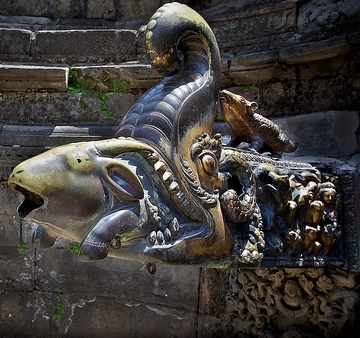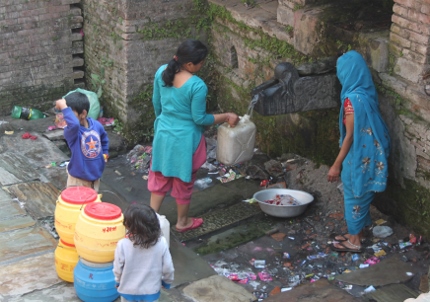Kamala Raut collects water every morning from the stone water spout in Bhatbhateni— just 200 metres away from the prime minister’s official residence in north-east Kathmandu.
But this stone spout, which has been providing water to many people in the area for centuries, is now running dry.
“I don’t have any options for water in my rented home so this is only the source of water” said Raut, as she filled up her bucket with water early one morning. “But in recent years the volume of water is decreasing and no maintenance has been done so I am worried, ” she told thethirdpole.net.
The queue of people behind Raut is a regular phenomenon. This is one of the very few remaining stone spouts in the valley that provides water to locals all year round. Almost half of the city’s 400 spouts have disappeared.
The stone water spouts— known as dhunge dhara in Nepali or Hiti in the Newari language — were the only the source of water for many people in the Kathmandu valley until a few decades ago. These community water systems were built over 2,000 years ago, long before modern pipe systems were introduced in the 1890s.
Stone spouts connecting to underground water channels were built at a time when providing water to people was once considered an act that expiated sins. However, since rulers of the Kathmandu valley built canals to supply water to the royal households in the seventeenth century – the valley’s ancient water system has fallen into disrepair.
Today around two-thirds of Kathmandu’s urban population is connected to the pipe system that supplies water for at most a few hours a couple of days in a week. The rest of the population relies on stone spouts, local wells and water tankers.
“Historically these spouts were the means of social communication as it was one of the major meeting place of the community members so it has archaeological value in addition to environmental services,” said Suresh Shrestha, chief archaeological officer at the Department of Archaeology, the government agency responsible for the upkeep of these monuments.
However, efforts to protect spouts have been negligible due to lack of money and human resources, Shrestha said. “We have to look after all monuments in the country that need immediate protection and spouts have not been our priority,” he added.

Communities fight to save water taps
Given the government’s inaction, some communities have tried to revive traditional water systems themselves. But their efforts have failed in the face of rampant extraction of ground water and growing urban sprawl. Kathmandu’s groundwater tables have been falling by over two metres a year, according to some estimates. The government has taken no action to stop this or the tide of concrete construction blocking up underground water streams.
Standing in front of the Sundhara (or “golden tap”) in Patan, one of the three historic cities of the Kathmandu valley, 72-year old Prem Baidya recalled his community’s fight against government moves to establish an industrial area near the water spout.
“We protested against the government’s move a decade ago, we even filled up those wells dug for providing water to workers in that industrial area but we failed; ultimately they established the area,” said Baidya.
He believes the new Patan industrial area was the major reason for the reduction of water coming out of the spout. “There used to be water in the spouts for almost nine months a year in the past but it’s hardly six months now,” he said.

Kathmandu faces acute water shortages. The public company responsible is not able to meet half of current water demand. For many people these spouts are still the only source of water for drinking and cooking.
“We get water for an hour every five days from the government system so it’s better not to count but if we could have maintained the stone spout then it could have provided us water all the time,” added Baidya.
“We collected funds personally and paved this spout area, but we can’t increase the water table on our own. The government has to discourage ground water extraction to save these historical water service providers” added Baidya.

